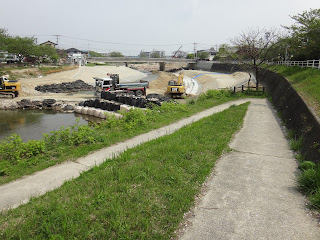I had promised my wife that I would eat before I came home, so I decided to stop at Mos Burger, where I knew they sell fried onion rings and chicken burgers. The red banner on the right asks the question, "What is your favorite burger?"
Reaching home, I stood in front of my building and took this picture of the fish goods store on the corner.
My wife and I found an ad for some kind of local flea market and decided to go. In Japanese, flea and free are phonetically the same, so many Japanese think that it is a free market, justifying the name by the low prices. We caught a bus and then had to walk about 10 minutes to the site.
The first place we went was inside the building where they had an actual flea market. There were clothes and lots of other odds and ends. We bought a jigsaw puzzle that we will do in the near future, when we have recovered from moving.Outside there were tents set up, with someone selling stuff in each tent. Again there were lots of clothes and many toys, but also other stuff.





















































